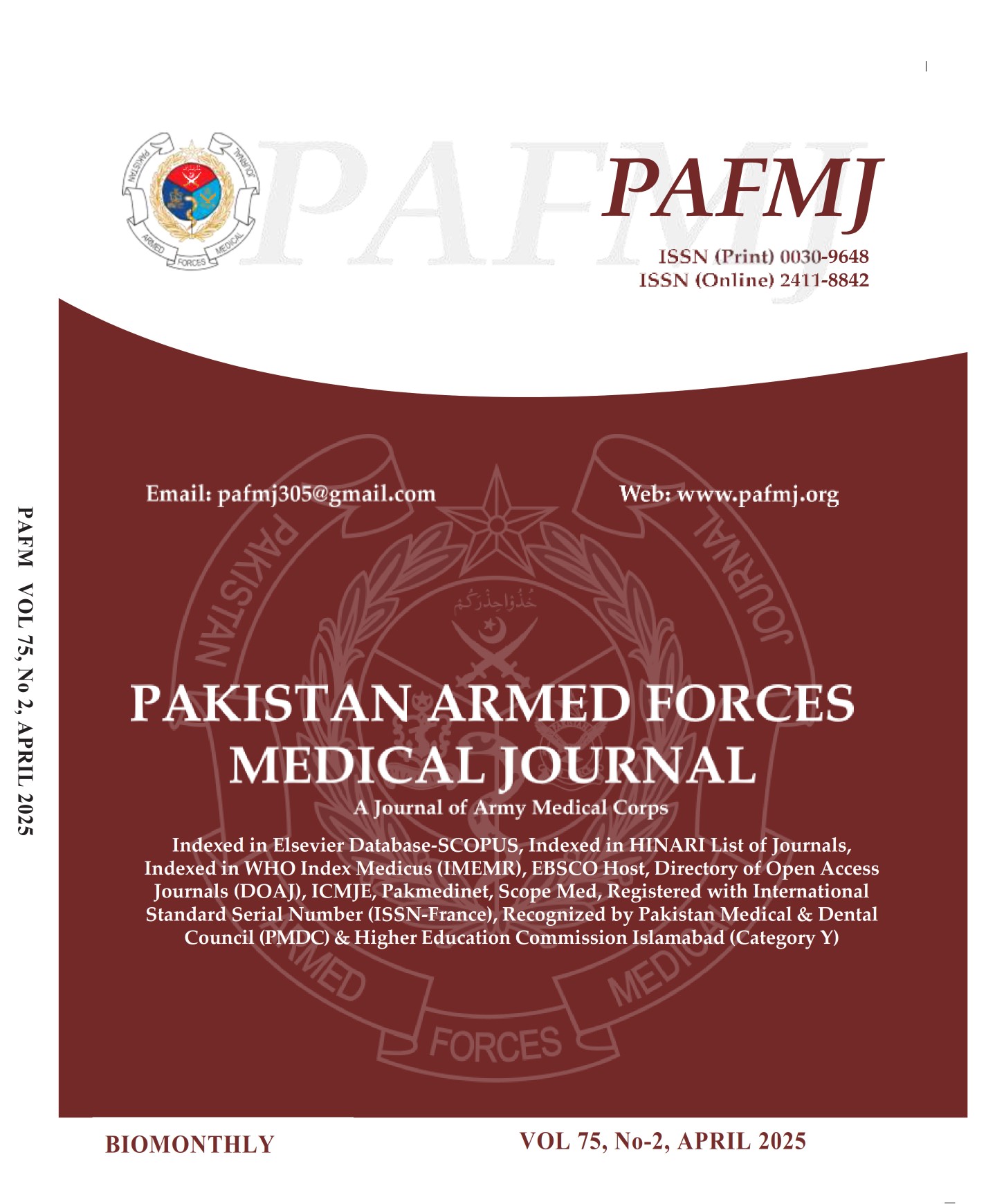Criteria for Classification of Inter-Radicular Septum Shape in Maxillary Molars with Clinical Importance for Immediate Implant Placemen
DOI:
https://doi.org/10.51253/pafmj.v75i2.11832Keywords:
Cone Beam Computerized Tomography, Immediate Implant Placement, Inter-Radicular SeptumAbstract
Objective: To explore the use of Cone Beam Computed Tomography to evaluate morphometric properties of the Inter-Radicular Septum in maxillary first and second molar region.
Study Design: Cross-sectional study.
Place and Duration of Study: Armed Forces Institute of Dentistry, Combined Military Hospital, Rawalpindi Pakistan, from Jul to Dec 2023.
Methodology: Cone Beam Computed Tomography scans of 177 patients, recruited via consecutive sampling technique were obtained and analyzed using NEWTOM software. Patients falling in the age range of 18-65 years, having first and second maxillary molars were included. The Inter-Radicular Septum morphometric properties of maxillary first and second molars were evaluated in coronal and axial plane. Inter-Radicular Septum widths and areas of M1 and M2 were compared at different levels by applying ANOVA/Kruskal Wallis test based upon data normality
Results: Out of 177 patients, 118(66.7%) were males, while 59(33.3%) were females with mean age 40.49±1.33 years. Frequency of arrow shape of molars (M1&M2) was highest [119(67.2%) and 136(76.8%) respectively]. Mean difference of Inter-Radicular Septum widths across all levels was significantly varied with respect to shapes of Molar 1 and Molar 2 as well (p<0.05). Boat shape of molar 1 & 2 had greatest furcation angle (60.14+12.85 and 56.12+11.01 respectively) and the mean difference was significant across different IRS shapes (p<0.001 and p=0.034 respectively). Inter-Radicular Septum surface area required for implant placement was most prominent in buccal convergence shape in maxillary first molar and boat shape in maxillary second molar.
Conclusion: Cone Beam Computed Tomography image analysis can serve as a ..
Downloads
References
Agostinelli C, Agostinelli A, Berardini M, Trisi P. Radiological evaluation of the dimensions of lower molar alveoli. Implant Dent 2018; 27(3): 271-275.
https://doi.org/10.1097/id.0000000000000757
Rodriguez-Tizcareño MH, Bravo-Flores C. Anatomically guided implant site preparation technique at molar sites. Implant dent 2009; 18(5): 393-401. https://doi.org/10.1097/id.0b013e3181b4b205
Deporter D, Dastgurdi ME, Rahmati A, Atenafu EG, Ketabi M. CBCT data relevant in treatment planning for immediate maxillary molar implant placement. J Adv Periodontol Implant Dent 2021; 13(2): 49. https://doi.org/10.34172%2Fjapid.2021.016
Liechtung M. A new approach to implant provisionalization. Dent Today 2012; 31(12): 70-74.
Agostinelli C, Agostinelli A, Berardini M, Trisi P. Anatomical and radiologic evaluation of the dimensions of upper molar alveoli. Implant Dent 2018; 27(2): 171-176.
https://doi.org/10.1097/id.0000000000000747
Pavlovic ZR, Milanovic P, Vasiljevic M, Jovicic N, Arnaut A, Colic D, et al. Assessment of maxillary molars interradicular septum morphological characteristics as criteria for ideal immediate implant placement—The advantages of cone beam computed tomography analysis. Diagnostics 2022; 12(4): 1010.
https://doi.org/10.3390/diagnostics12041010
Bleyan S, Gaspar J, Huwais S, Schwimer C, Mazor Z, Mendes JJ, et al. Molar septum expansion with osseodensification for immediate implant placement, retrospective multicenter study with up-to-5-year follow-up, introducing a new molar socket classification. J Funct Biomater 2021; 12(4): 66.
https://doi.org/10.3390/jfb12040066
Hayacibara RM, Gonçalves CS, Garcez‐Filho J, Magro‐Filho O, Esper H, Hayacibara MF. The success rate of immediate implant placement of mandibular molars: a clinical and radiographic retrospective evaluation between 2 and 8 years. Clin oral implants res 2013; 24(7): 806-811.
https://doi.org/10.1111/j.1600-0501.2012.02461.x
Smith RB, Tarnow DP. Classification of molar extraction sites for immediate dental implant placement. Int J Oral Maxillofacial Implants 2013; 28(3). https://doi.org/10.11607/jomi.2627
Rahardjo P. Prevalence of hypodontia in Chinese orthodontic patients. Dent J 2006; 39(4).
http://doi.org/10.20473/j.djmkg.v39.i4.p147-150
Schulze RK, Drage NA. Cone-beam computed tomography and its applications in dental and maxillofacial radiology. Clin radiol 2020; 75(9): 647-657. https://doi.org/10.1016/j.crad.2020.04.006
Jacobs R, Salmon B, Codari M, Hassan B, Bornstein MM. Cone beam computed tomography in implant dentistry: recommendations for clinical use. BMC oral health. 2018; 18: 1-6.
https://doi.org/10.1186/s12903-018-0523-5
Friedlander-Barenboim S, Hamed W, Zini A, Yarom N, Abramovitz I, Chweidan H, et al. Patterns of cone-beam computed tomography (CBCT) utilization by various dental specialties: a 4-year retrospective analysis from a dental and maxillofacial specialty center. Healthcare 2021; 9(8): 1042. https://doi.org/10.3390/healthcare9081042
Regnstrand T, Ezeldeen M, Shujaat S, Ayidh Alqahtani K, Benchimol D, Jacobs R. Three‐dimensional quantification of the relationship between the upper first molar and maxillary sinus. Clin Exp Dent Res 2022; 8(3): 750-756. https://doi.org/10.1002/cre2.561
Padhye NM, Shirsekar VU, Bhatavadekar NB. Three-dimensional alveolar bone assessment of mandibular first molars with implications for immediate implant placement. Int J Periodontics Restortive Dent 2020; 40: e163-167.
https://doi.org/10.11607/prd.4614
De Souza Nunes LS, Bornstein MM, Sendi P, Buser D. Anatomical characteristics and dimensions of edentulous sites in the posterior maxillae of patients referred for implant therapy. Int J periodontics restorative dent 2013; 33(3).
https://doi.org/10.11607/prd.1475
Demirkol N, Demirkol M. The diameter and length properties of single posterior dental implants: a retrospective study. Cumhuriyet Dent J 2019; 22(3): 276-282.
https://doi.org/10.7126/cumudj.541657
Thirunavakarasu R, Arun M, Abhinav RP, Ganesh BS. Commonly Used Implant Dimensions in the Posterior Maxilla-A Retrospective Study. J Long-Term Effects Med Implants 2022; 32(1).
https://doi.org/10.1615/jlongtermeffmedimplants.2021038617
Shokry M, Taalab M. Immediate implant placement through inter-radicular bone drilling before versus after roots extraction in mandibular molar area (a randomized controlled clinical trial). Egyptian Dent J 2022; 68(2): 1377-1388.
https://dx.doi.org/10.21608/edj.2022.116886.1952
Demırcan S. Prosthetically driven immediate implant placement at lower molar area; an anatomical study. Eur Oral Res 2020; 54(1): 25-30. https://doi.org/10.26650/eor.20200059
Wagenberg B, Froum SJ. A Retrospective Study of 1,925 Consecutively Placed Immediate Implants From 1988 to 2004. Int J Oral Maxillofacial Implants 2006; 21(1).
http://dx.doi.org/10.1016/j.prosdent.2006.05.016
Fugazzotto PA. Implant placement at the time of mandibular molar extraction: Description of technique and preliminary results of 341 cases. J periodontol 2008; 79(4): 737-747.
https://doi.org/10.1902/jop.2008.070293
Sanz M, Cecchinato D, Ferrus J, Pjetursson EB, Lang NP, Lindhe J. A prospective, randomized‐controlled clinical trial to evaluate bone preservation using implants with different geometry placed into extraction sockets in the maxilla. Clin oral implants res 2010; 21(1): 13-21.
Downloads
Published
Issue
Section
License
Copyright (c) 2025 Sana Khalid, Mubashir Sharif, Anis ur Rehman, Asifa Abbas, Wagma Ayub, Naseem Azad

This work is licensed under a Creative Commons Attribution-NonCommercial 4.0 International License.















